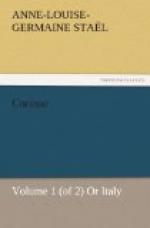Mount Esquiline was called the Poets’ Mount, because Mecenas having his palace on this hill, Horace, Propertius and Tibullus dwelt there also. Not far from here are the ruins of the Thermae of Titus, and of Trajan. It is believed that Raphael took the model of his arabesques from the fresco paintings of the Thermae of Titus. It is there, also, that was discovered the group of the Laocoon. The freshness of water affords such pleasure in hot countries that delight is taken in assembling together all the pomp of luxury, and every enjoyment of the imagination, in the places appropriated for bathing. It was there that the Romans exposed their masterpieces of painting and of sculpture. They were seen by the light of lamps, for it appears by the construction of these buildings, that daylight never entered them: they wished thus to preserve themselves from the rays of the sun, so burning in the south: the sensation they produce must certainly have been the cause of the ancients calling them the darts of Apollo. It is reasonable to suppose, from observing the extreme precaution of the ancients to guard against heat, that the climate was then more burning than it is in our days. It is in the Thermae of Caracalla, that were placed the Hercules Farnese, the Flora, and the group of Dirce. In the baths of Nero near Ostia was found the Apollo Belvedere. Is it possible to conceive that in contemplating this noble figure Nero did not feel some generous emotions?
The Thermae and the Circuses are the only kind of buildings appropriated to public amusements of which there remain any relics at Rome. There is no theatre except that of Marcellus whose ruins still exist. Pliny relates that there were three hundred and sixty pillars of marble, and three thousand statues employed in a theatre, which was only to last a few days. Sometimes the Romans raised fabrics so strong that they resisted the shock of earthquakes; at others they took pleasure in devoting immense labour to buildings which they themselves destroyed as soon as their feasts were over; thus they sported with time in every shape. Besides, the Romans were not like the Greeks—influenced by a passion for dramatic representations. It was by Grecian work, and Grecian artists, that the fine arts flourished at Rome, and Roman greatness expressed itself rather by the colossal magnificence of architecture than by the masterpieces of the imagination. This gigantic luxury, these wonders of riches, possess great and characteristic dignity, which, though not the dignity of liberty, is that of power. The monuments appropriated for public baths, were called provinces; in them were united all the divers productions and divers establishments which a whole country can produce. The circus (called Circus Maximus) of which the remains are still to be seen, was so near the palace of the Caesars that Nero could from his windows give the signal for the games. The circus was large enough to contain three hundred thousand persons. The nation almost in its entirety was amused at the same moment, and these immense festivals might be considered as a kind of popular institution, which united every man in the cause of pleasure as they were formerly united in the cause of glory.




